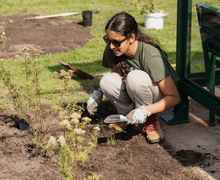Students, faculty share their thoughts on new campus safety app Orange Safe
Wendy Wang | Asst. Photo Editor
Syracuse University’s Department of Public Safety launched Orange Safe, a new campus safety app, on Aug. 22.
Get the latest Syracuse news delivered right to your inbox.
Subscribe to our newsletter here.
Syracuse University’s Department of Public Safety launched Orange Safe, a new campus safety app, on Aug. 22. The new app replaced the Rave Guardian app, which SU has used since Feb. 2021.
Orange Safe provides students, faculty and staff a number of tools to stay connected and receive important campus notifications, communicate with campus safety and get access to resources needed the most, according to the DPS website.
SU worked in partnership with AppArmor to make the app as simple as possible while providing the most important safety related information to the campus community, said Christine Weber, the communications manager at Campus Safety and Emergency Management Services, in an email to The Daily Orange.
Shabeeb Ameen, a graduate student in the College of Arts and Sciences who also works as a teaching assistant, appreciated that the app also connects members of the community to resources available at the Barnes Center at the Arch.
Ameen said he would tell his students to download the app on the first day of class if he knew about it, especially if they are taking a late-night class. He said the university could make posters with the QR code for the app to promote downloads.
Kfir Shoham, a freshman in the College of Arts and Sciences, said his parents told him to download the app on his phone but he’s never used it.
“I don’t feel the need to use it yet, so I haven’t found it useful,” he said.
Chris Cho, a first-year doctoral student studying philosophy, said that he did not know about the app prior to being interviewed. Cho thinks DPS could put up more posters advertising the app and the resources it has for students. Cho said he uses the Safety Escort Shuttle, which operates every night from 8 p.m. to 6 a.m.
Students tend not to read university-wide emails carefully, Cho said, so promoting the app that way wouldn’t be as effective.
After downloading the app, Cho said once he was more familiar with the tools and functions of Orange Safe, thought there should be a better way to present the resources the app contains.
“If I go to a safety escort shuttle and I go to a shuttle area of operation, then they give me the entire web page. But I feel like they could just extract what’s important from the web page and then (present) it in a much more friendly manner,” Cho said.
At the top of the homepage, the app has a banner announcing DPS’ latest news. The function is positioned above a red emergency contact button for 911 and nine other functions.
Jeff Passetti, a professor who teaches web design at SU, said the homepage banner may not be the best location to put the announcements.
“All the important stuff I think (should be) right on top,” Passetti said. “That’s nice, if it’s informative about emergencies or crises. But right now it’s advertising what’s going on with the Department of Public Safety in terms of public relations and blogs.”
The functions include a map of SU’s Blue Lights, reporting tips to DPS, a “safety toolbox”— which can send a message indicating the user is okay to a recipient of their choosing — and general support resources.
“I think the main battle now is not the design, the awareness of the app is probably the largest obstacle that they’ll face,” Passetti said.
Weber told The D.O. that the app has 3,607 subscribers as of Friday.
Passetti also mentioned some smartphone default systems will automatically delete apps that are not used in months, leaving him worried that students not using the app may have to redownload the app in a moment of crisis. He said 20 to 3o seconds of downloading could be critical to students’ safety.
Adam Peruta, an associate magazine, news and digital journalism professor in the Newhouse School of Public Communications, has designed several apps, including ’Cuse Challenge — which encourages SU students to participate in campus culture — and Yank Alerts, a personal safety app. Peruta, who teaches interactive design and UI/UX, said SU hasn’t done enough research on what students want in a safety app.
“I think the problem is that when you’re not really understanding your audience, you end up designing something that you think people are going to use and it ends up being totally off base,” Peruta said.
Despite the design flaws, the app has features that function well, and students should be aware of them, Peruta said. However, he added that members of Generation Z have very high expectations for their digital experiences.
“If you don’t meet those expectations,” he said, “people are not going to use the app.”
Published on September 11, 2022 at 11:37 pm






